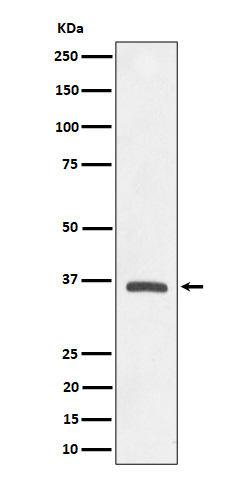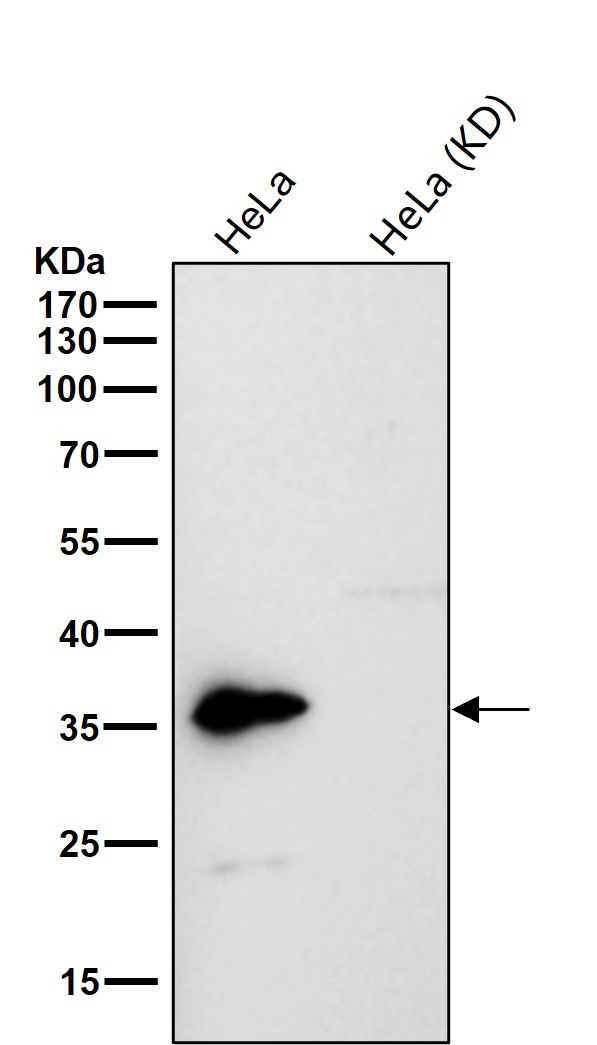

| WB | 咨询技术 | Human,Mouse,Rat |
| IF | 咨询技术 | Human,Mouse,Rat |
| IHC | 咨询技术 | Human,Mouse,Rat |
| ICC | 1/50-1/200 | Human,Mouse,Rat |
| FCM | 1/20-1/100 | Human,Mouse,Rat |
| Elisa | 咨询技术 | Human,Mouse,Rat |
| Aliases | GPR80; GPR99; Oxgr1; P2RY15; P2Y15;;OXGR1 |
| WB Predicted band size | Calculated MW: 38 kDa ; Observed MW: 36 kDa |
| Host/Isotype | Rabbit IgG |
| Antibody Type | Primary antibody |
| Storage | Store at 4°C short term. Aliquot and store at -20°C long term. Avoid freeze/thaw cycles. |
| Species Reactivity | Human,Mouse,Rat |
| Immunogen | A synthesized peptide derived from human OXGR1 |
| Formulation | Purified antibody in PBS with 0.05% sodium azide,0.05% BSA and 50% glycerol. |
+ +
以下是关于OXGR1/GPR99抗体的3篇参考文献的简要信息:
1. **"Identification of GPR99 as a novel G protein-coupled receptor for the organic anion 2-oxoglutarate"**
*作者:He W. 等人 (2004)*
**摘要**:该研究首次克隆并鉴定了GPR99(后更名为OXGR1)作为α-酮戊二酸(2-oxoglutarate)的受体,并开发了针对该受体的多克隆抗体,用于检测其在肾脏和肺组织中的表达定位。
2. **"OXGR1 is a candidate downstream effector of progesterone receptor in renal epithelial cells"**
*作者:Guo R. 等人 (2012)*
**摘要**:研究探讨了OXGR1在肾脏酸碱平衡调节中的作用,通过免疫组织化学和Western blot技术,使用特异性抗体验证了OXGR1在肾小管细胞中的表达及其对孕酮信号的响应机制。
3. **"A monoclonal antibody against GPR99/oxgr1 reveals its role in neutrophil migration and tissue inflammation"**
*作者:Luo J. 等人 (2018)*
**摘要**:该文献报道了一种新型抗GPR99单克隆抗体的开发,并利用该抗体揭示了GPR99在中性粒细胞迁移和炎症反应中的关键作用,为治疗炎症性疾病提供了潜在靶点。
4. **"Protease-activated receptor 2 and OXGR1 interact to regulate inflammatory responses in the lung"**
*作者:Ahmed K. 等人 (2020)*
**摘要**:研究结合免疫沉淀和共聚焦显微镜技术,使用OXGR1特异性抗体阐明了其与PAR2受体的相互作用机制,及其在肺部炎症信号通路中的协同调控功能。
以上文献均聚焦于OXGR1/GPR抗体的开发或应用,涵盖受体功能验证、疾病机制探索及治疗潜力分析。
OXGR1 (2-oxoglutarate receptor 1), also known as GPR99. is a class A G protein-coupled receptor (GPCR) that belongs to the α-ketoglutarate receptor family. It was initially identified as an orphan receptor until studies revealed its activation by α-ketoglutarate (α-KG), a tricarboxylic acid cycle intermediate, and other oxocarboxylic acids like succinate and fumarate. Structurally, OXGR1 contains seven transmembrane domains and signals primarily through Gq/11 proteins, leading to intracellular calcium mobilization. This receptor is expressed in various tissues, including the kidney, ovary, spleen, and immune cells, suggesting roles in pH homeostasis, inflammation, and cellular metabolism.
Antibodies targeting OXGR1/GPR99 are critical tools for studying its expression, localization, and function. They enable detection in complex biological samples via techniques like Western blotting, immunohistochemistry, and flow cytometry. Research using these antibodies has linked OXGR1 to renal tubular acidosis, asthma, and tumor microenvironment regulation. For instance, in the kidney, OXGR1 modulates bicarbonate transport, while in immune cells, it may influence inflammatory responses. Recent studies also explore its potential as a therapeutic target in metabolic disorders and cancer. However, challenges remain in characterizing its precise signaling mechanisms and ligand specificity, necessitating validated antibodies to minimize cross-reactivity with related GPCRs. Overall, OXGR1 antibodies advance understanding of its physiological and pathological roles, bridging gaps between receptor biology and disease intervention strategies.
×